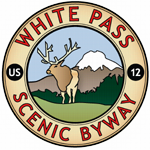The 124-mile aptly-named White Pass Scenic Byway runs between Chehalis and White Pass. Even non-hikers will find the drive enjoyable with too many points of interest to describe in detail amidst a wealth of recreational and lodging opportunities. The byway is chockablock with historical museums, lakes to fish or swim, hiking trails, logging exhibits, fairs and more.
Lest this quiet route fool you into thinking these towns are small-town, think again. The towns may be small with an old-fashioned flair but they are also up to date on other important things that never go out of date such as good movies, coffee, grub and shops.
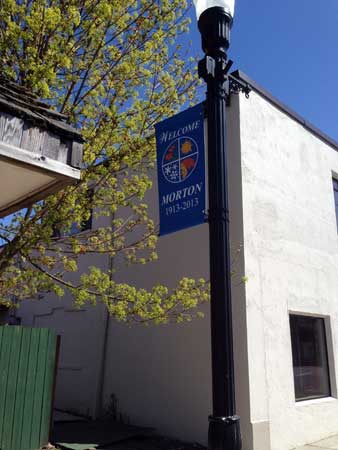
Downtown Morton
Morton
Morton lives up to its reputation as a logging town and some of the best-tasting coffee we’ve found anywhere at the Bean Tree on Main Street. Morton still has few streetlights and though the town has changed a lot since 1911 – what hasn’t changed is its small-town personality in the best sense of the word. Some small towns feel insular bu t not Morton, a pleasant blend of the new and the historic. The historic Roxy Theater (built in 1937) is but one attraction – Morton is loaded with thrift stores, a sign of boom or bust towns and you can still hear the growl of Jake-brakes as logging trucks roll through town, replacing locomotives of yore.
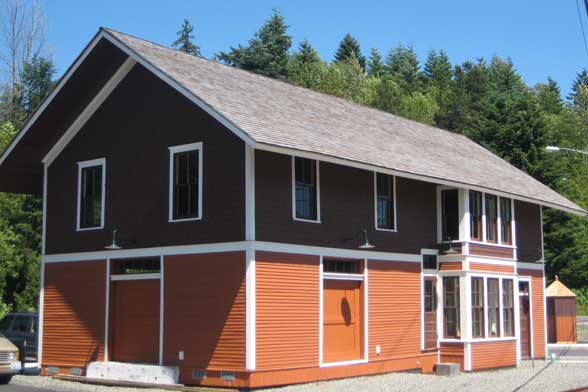
Historic Morton Train Depot
If you are a railroad buff don’t miss the Morton Depot (originally built in 1910); it is in the process of being lovingly transformed into a Museum and Visitor Center with the original railroad being the main focus. Morton was once the railroad tie capitol of the world. The depot is next to the Morton Visitor Center which opens Memorial Day weekend.
Our timing was fortuitous; though the Morton Visitor Center had not opened its doors for the season we stopped for photos. Here we ran into Marc Fisher, President of the Cowlitz River Valley Historical Society who explained the museum is still under construction. Marc is enthusiastic and happy to answer our questions as he talked about the history and restoration of the depot. Though the depot is not open he took us on a tour of the depot with its high ceilings and windows (the windows were the depots original glass – old glass is indicated by a slight wavy appearance in certain slants of light). Old furnishings have been replicated to appear like the originals.
We climbed the original steep stairs to the second floor of the depot which once served as living quarters. From the second floor Marc pointed out a foothill named Peterman Hill named for an early Morton resident who established the Peterbilt Truck Company. The Morton Visitor Center is open on weekends, from Memorial Day weekend to Labor Day from 10 a.m. to 4 p.m. Before leaving Morton we stopped for coffee and fresh cookies at the Bean Tree in Morton which we enjoyed immensely (2112 Main Street), open Mondays-Fridays, 8 a.m. to 3 p.m., closed on weekends except for special events. If you enjoy coffee and cookies as much as we do you might find it hard to leave Morton.
Taidnapam Campground and Riffe Lake
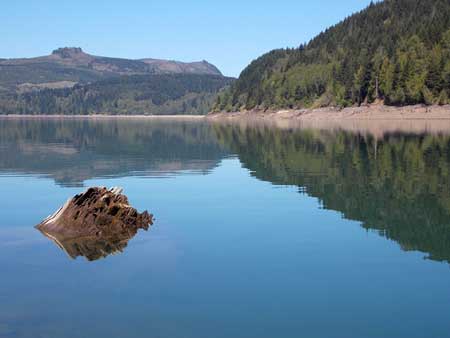
A View of Riffe Lake
From Morton we continued east on US Highway 12 to Kosmos Road (milepost 103) where we turned right onto Kosmos Road to check out the Taidnapam Campground and Riffe Lake. From Kosmos Road it is about 3.9 miles to the Taidnapam Campground located on the shores of Riffe Lake. Riffe Lake is a man-made lake formed when the Mossyrock Dam was built. Though hard to picture today; under the sparkling waters of Riffe Lake lay the town-sites of Kosmos and Riffe, two towns that were covered over by water when the dam was built. Purportedly you can see parts of these town-sites by boat if you know where to look. Though the 23-mile long lake is man-made, it is a pretty lake, especially on a sunny day when the lake sparkles with highlights. The lake was named for Riffe, once a small pioneering community.
The Mossyrock Dam (completed in 1968) at over 600 feet high is Washington’s tallest dam and today serves more than 78,000 homes in the Pacific Northwest. From the town of Mossyrock the dam is 3 miles east on US 12 featuring a Hydrovista with an overlook and interpretive displays.
You can’t help but wonder how some towns acquire their names. We learned after a stop at the White Pass Country Museum in Packwood. A Mrs. B.W. Coiner came up with the name Glenoma – “glen” from the word for valley and “oma”, a Greek work for “very fruitful”. Kosmos, another extinct settlement was established in 1904; its heyday was in the 1940s with logging camps and mills. Kosmos was also abandoned when the Mossyrock Dam was built. An Ida Hare Coiner known for her literary expertise came up with the name of Kosmos (Kosmos being the Greek word for “universe”).
At the Taidnapam Boat Launch/Campground – camping is allowed in specified areas; (swimming is not permitted); the campground will open Memorial Day weekend. Though this surrounding area has been logged – and is still being logged – green foothills still rise above the lake and where the trees have been thinned out you can make out the shapes of the land, like viewing the bones of a prehistoric giant laid to rest. A dock extends out into the lake for boaters’ ease in launching their craft. These parks are managed by Tacoma Power – call 1-888-502-8690 for additional information. No Discover Pass is required.
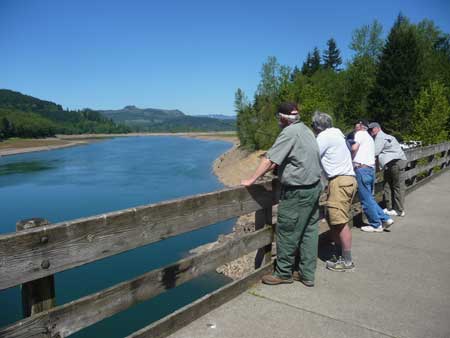
Visitors enjoy views from the Fishing Bridge
Enjoy the view from the Fishing Bridge Our next stop was The Fishing Bridge a few miles further down the road (follow signs) We could see the bridge is aptly named as this is where the Cowlitz River flows into Riffe Lake and on this sunny morning fishermen lined the bridge, casting their lines and hopes. It was the kind of day you wouldn’t mind waiting for a bite; the sun was warm, the river a clear blue-green and it felt like Time was standing still.
A bridge used by logging trucks parallels the Fishing Bridge; standing or walking on that bridge is prohibited. Jumping off either bridge is also prohibited though there is a Swimming Area for those who wish to encourage goose-bumps. To get to the swimming area from the parking area walk through the large culvert that leads to a playground and the designated swimming beach (wait until it gets warm before jumping in, that water’s cold!).
Packwood
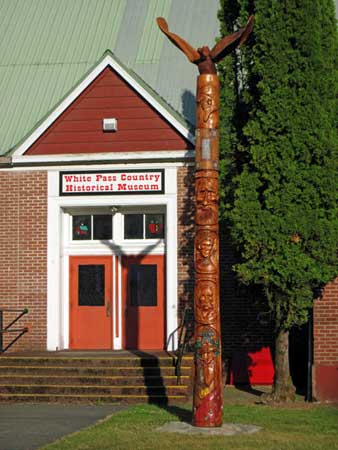
White Pass Country Museum
We stopped in Packwood to revisit the White Pass County Museum which is located on the main drag through Packwood (US Highway 12). We’d stopped there before and as in our first visit, we lost track of time. The volunteers who man the museum are living, breathing, talking encyclopedias of the regions history and lore. Their knowledge of the Upper Cowlitz Valley (from Kosmos to White Pass) is munificent. The museum is located in the handsome Packwood school building (built in 1939). In the summer the museum is open from noon to 5 p.m. (Thursday, Friday and Saturday). Their winter hours are Saturdays 12 to 4 p.m. (or by appointment). The $2 fee to enter the museum seems hardly enough considering the wealth within (see additional information on how to become a member of the White Pass Country Historical Society). Displays range from logging equipment, to displays of pioneer life complete with clothing, antique sewing machines, quilts (some are for sale), old photographs including Ohanapecosh Hot Springs which we found especially fascinating.
For additional information on the White Pass Country Historical Society visit their website at www.whitepasscountrymuseum.org or call 360-494-4422 (recorded message). The museum is located at 12990 US Highway 12 in Packwood.
Between Packwood and Morton on our drive back we passed an abandoned farm where lilacs were in bloom. We couldn’t resist stopping for a bouquet to take back to Seattle as a sweet reminder of this fascinating region, one we will return to often.
By Karen Sykes for the White Pass Scenic Byway
